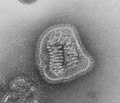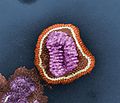ファイル:Influenza virus particle 8430 lores.jpg

このプレビューのサイズ: 701 × 600 ピクセル。 その他の解像度: 281 × 240 ピクセル | 561 × 480 ピクセル | 898 × 768 ピクセル | 1,197 × 1,024 ピクセル | 1,663 × 1,423 ピクセル。
元のファイル (1,663 × 1,423 ピクセル、ファイルサイズ: 763キロバイト、MIME タイプ: image/jpeg)
ファイルの履歴
過去の版のファイルを表示するには、その版の日時をクリックしてください。
| 日付と時刻 | サムネイル | 寸法 | 利用者 | コメント | |
|---|---|---|---|---|---|
| 現在の版 | 2010年11月19日 (金) 08:45 |  | 1,663 × 1,423 (763キロバイト) | Masur | original resolution |
| 2006年5月2日 (火) 19:35 |  | 700 × 598 (45キロバイト) | Patho | {{Information| |Description=PHIL Image 8430 ID#: 8430 Description: This negative-stained transmission electron micrograph (TEM) depicts the ultrastructural details of an influenza virus particle, or “virion”. A member of the taxonomic family Orthomyx |
ファイルの使用状況
以下の 3 ページがこのファイルを使用しています:
グローバルなファイル使用状況
以下に挙げる他のウィキがこの画像を使っています:
- be.wikipedia.org での使用状況
- cs.wikipedia.org での使用状況
- de.wikipedia.org での使用状況
- de.wikibooks.org での使用状況
- en.wikipedia.org での使用状況
- es.wikipedia.org での使用状況
- et.wikipedia.org での使用状況
- eu.wikipedia.org での使用状況
- fa.wikipedia.org での使用状況
- fr.wikipedia.org での使用状況
- he.wikipedia.org での使用状況
- hy.wikipedia.org での使用状況
- it.wikipedia.org での使用状況
- lt.wikipedia.org での使用状況
- ml.wikipedia.org での使用状況
- nl.wikipedia.org での使用状況
- ru.wikipedia.org での使用状況
- sr.wikipedia.org での使用状況



